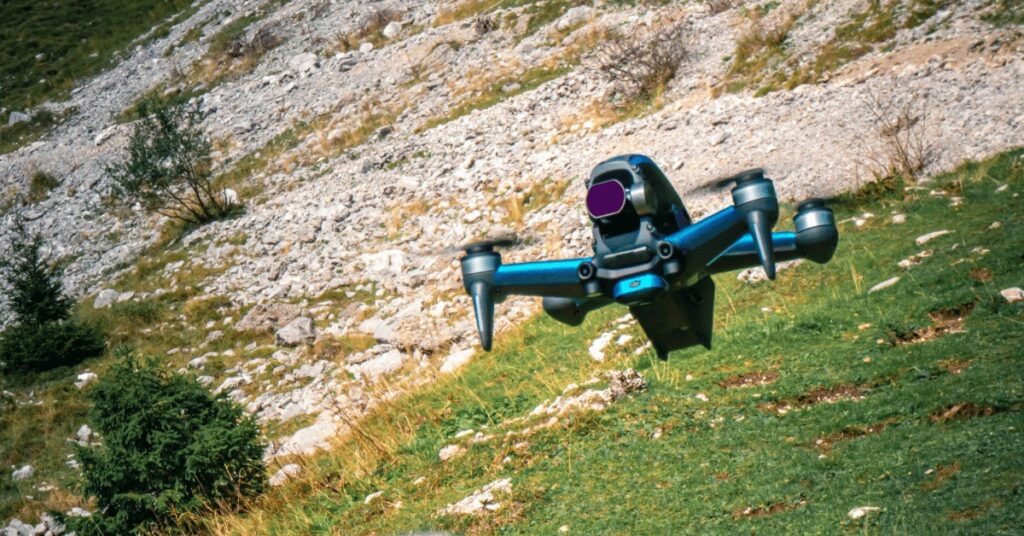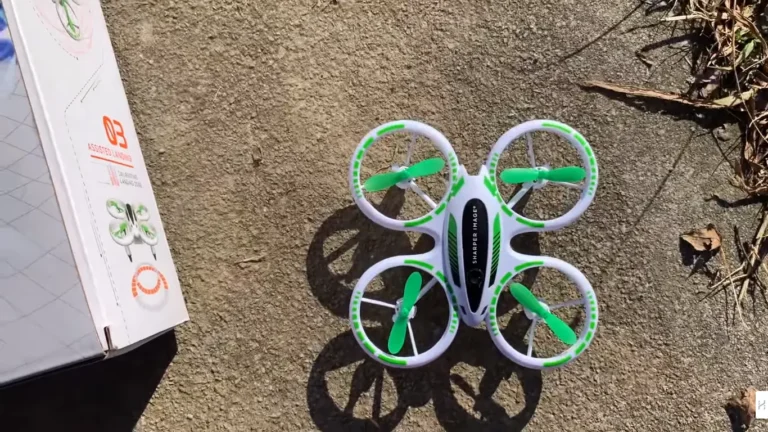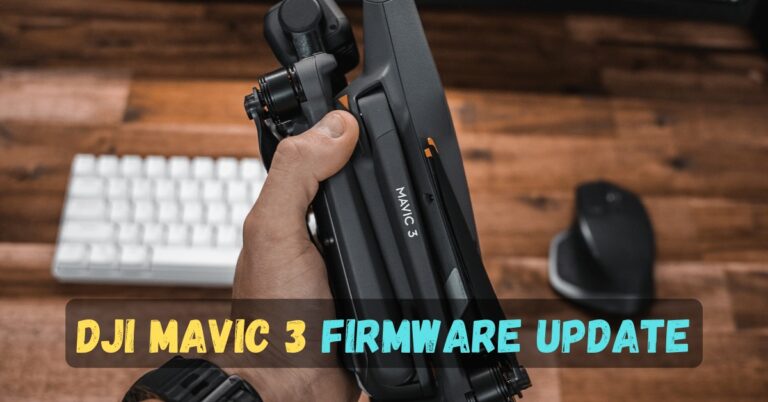How to Take Off and Land DJI FPV? Step-by-Step Guide.

Flying a DJI FPV drone can be an exhilarating experience, but it requires skill and knowledge to ensure safe and successful flights. One of the most critical aspects of flying a DJI FPV drone is taking off and landing correctly.
Whether you’re a beginner or an experienced FPV pilot, mastering the takeoff and landing process is essential to ensure your drone remains undamaged and can fly confidently.
In this article, we’ll provide a step-by-step guide to taking off and landing your DJI FPV drone like a pro, as well as some essential pre-flight checks, safety tips, troubleshooting advice, and advanced techniques to enhance your overall flying experience. Let’s dive in!
How to Take Off and Land DJI FPV? The Basics
Taking off and landing with DJI FPV can seem daunting, especially if you’re new to flying drones. However, with some practice and essential knowledge, you can quickly become confident in safely taking off and landing your DJI FPV drone.
Pre-Flight Checks
Before taking off, it’s essential to perform pre-flight checks to ensure that your drone is in good condition and that you comply with local laws and regulations.
- Check the battery level and ensure that it’s fully charged.
- Check that the propellers are firmly attached and that there are no signs of damage.
- Ensure that the SD card is inserted correctly and has sufficient storage space.
- Check the weather and wind conditions to ensure safe flying.
Taking Off
Once you’ve completed your pre-flight checks, it’s time to take off. Here’s how to do it:
- Ensure the drone is in GPS mode and the Home Point has been set.
- Turn on the remote control and the drone.
- Push the left joystick up gently to lift the drone off the ground.
- Hover the drone a few feet above the ground to ensure everything works correctly before proceeding with your flight.
Landing
Landing your DJI FPV drone is as important as taking off and requires careful attention to detail. Here’s how to do it:
- Hover the drone at an appropriate altitude and distance from your landing spot.
- Slowly bring the drone down to the ground using the left joystick.
- Once the drone is close to the ground, hold down the left joystick to reduce its speed and prevent it from bouncing.
- Once the drone has landed, ensure the propellers have completely stopped before turning off the drone and the remote control.
What pre-flight checks are essential for safe takeoff and landing with DJI FPV?
Before you take off with your DJI FPV drone, you must perform several critical pre-flight checks to ensure a safe and successful flight. Here are some essential pre-flight checks to keep in mind:
Check Your Battery
One of the most necessary pre-flight checks is to ensure that your DJI FPV drone’s battery is charged and securely installed. Ensure your battery has sufficient charge to complete your planned flight and ensure it’s correctly installed and locked in place.
Check Your Props
Your DJI FPV drone’s props are another essential component to check before takeoff. Inspect each propeller for any signs of damage, such as cracks or chips, and ensure they’re correctly installed and tightened.
It’s also a good idea to carry a spare set of props if you need to replace them in the field.
Check Your Controls
Before you take off, ensure you have a clear signal between your DJI FPV drone and your remote controller.
Ensure that all controls are working correctly and that you’ve calibrated your compass and GPS. It’s also good to check that your drone’s firmware and controller’s software are current.
Check Your Environment
Finally, before takeoff, take a moment to assess your environment. Look for potential hazards, such as power lines, trees, or other obstacles that could interfere with your flight.
Make sure that you’re in a clear, open space with plenty of room to maneuver and that the weather conditions are suitable for flying.

By performing these essential pre-flight checks, you can help ensure a safe and successful flight with your DJI FPV drone. Preparing properly before takeoff can help prevent accidents and keep your drone in top condition.
How can you master takeoff and landing techniques with DJI FPV?
Mastering the takeoff and landing techniques with your DJI FPV drone is crucial for a smooth and successful flight. Here are some tips and tricks that can help you take off and land your DJI FPV like a pro:
Practice Makes Perfect
Like any other skill, practice is key to mastering takeoff and landing techniques with DJI FPV. Start by finding a safe and open area to practice, such as an empty field or park.
Begin with simple takeoffs and landings and gradually work up to more complex maneuvers.
Use the DJI Flight Simulator
If you’re new to flying DJI FPV drones, practicing in a simulated environment before taking off with your real drone is essential. DJI offers a free flight simulator that allows you to practice takeoff, flying, and landing in a virtual environment.
It’s a great way to get comfortable with the controls and build confidence before flying your DJI FPV drone in the real world.
Maintain a Clear Line of Sight
Always maintain a clear line of sight when taking off and landing your DJI FPV drone. Keep an eye on the drone at all times and ensure no obstacles in its flight path. If flying in a crowded area, keep a safe distance from people and objects to avoid accidents.
Use Visual Aids
Utilize visual aids to help guide your takeoff and landing. The DJI FPV drone comes equipped with an obstacle avoidance system, but it’s still a good idea to use visual aids, such as cones or markers, to help you determine your landing zone.
It will also help you stay safe from people and objects while landing your drone.
Pay Attention to Weather Conditions
Always check the weather conditions before flying your DJI FPV drone. Avoid flying in strong winds, rain, or thunderstorms. Strong winds can cause your drone to lose control and potentially crash, while rain and thunderstorms can damage your drone’s electronics.
Following these tips and tricks, you can master takeoff and landing techniques with your DJI FPV drone and confidently fly. Remember always to prioritize safety and follow the guidelines set by DJI to ensure a successful and enjoyable flying experience.
READ MORE: Can you fly an FPV drone without goggles?
What is the step-by-step guide for taking off and landing DJI FPV like a pro?
Preparing for takeoff
Before taking off with your DJI FPV drone, you should take a few important steps to ensure a safe and successful flight.

Check your surroundings
First, make sure you’re in a suitable flying location. Look around and check for any obstacles interfering with your flight, such as trees, power lines, or buildings.
It’s also important to ensure that there are no people or animals in the vicinity, as drones can be dangerous if they collide with someone or something.
Check your equipment
Before takeoff, it’s crucial to ensure that your DJI FPV drone is in good condition and its components are functioning correctly. Check the battery levels, the condition of the propellers, and ensure that the remote control is properly synced with the drone.
Taking off
Now that you’ve completed the necessary checks, it’s time to take off!
Power on the drone
Begin by powering on your DJI FPV drone by pressing and holding the power button. The drone’s lights will flash to indicate it’s ready to fly.
Raise the drone
Using the joysticks on the remote control, gradually increase the throttle until the drone lifts off the ground. Once the drone is airborne, use the joysticks to stabilize it and adjust its altitude as needed.
Landing
Landing your DJI FPV drone safely requires some skill and finesse.
Find a suitable landing spot.
Before beginning the landing process, ensure you’ve located a suitable landing spot. It should be flat, clear of obstacles, and away from people or animals.
Begin the descent
To begin the landing process, reduce the throttle on your remote control to gradually lower the drone towards the ground. Use the joysticks to maintain control and ensure that the drone lands smoothly.
Power off the drone
Once the drone has landed, power it off by pressing and holding the power button. It will help conserve battery life and ensure the drone is ready for your next flight.
Following these step-by-step instructions, you can take off and land your DJI FPV drone like a pro in no time! Always prioritize safety and practice flying in a controlled environment before attempting more complex maneuvers.
What tips and tricks can you use for smooth takeoff and landing with DJI FPV?
One of the most challenging aspects of flying a DJI FPV drone is taking off and landing smoothly. Operating a fast-moving and expensive drone can be intimidating, but with some tips and tricks, you can improve your takeoff and landing skills.

Tip #1: Plan Your Takeoff and Landing Spot
Before taking off with your DJI FPV drone, choose a flat and obstacle-free area as your takeoff and landing spot. It’s essential to have a clear line of sight to avoid collisions and accidents.
Tip #2: Control Your Throttle
When taking off with your DJI FPV drone, gradually increase the throttle until it lifts off the ground. Be careful not to push the throttle too hard, as it can cause the drone to flip over or crash. When landing, reduce the throttle gradually to prevent the drone from falling too fast.
Tip #3: Use Your Controller’s Buttons
DJI FPV drones come equipped with buttons on the controller to help you control your drone more precisely. For example, you can use the C1 and C2 buttons to adjust your drone’s altitude, speed, and orientation while in flight. You can activate Sport mode using the S button for faster and more agile flights.
Tip #4: Pay Attention to Wind Conditions
Wind conditions can significantly impact your DJI FPV drone’s takeoff and landing, so checking the weather forecast before flying is crucial. Avoid flying in high winds or gusty conditions, which can cause the drone to lose stability and control.
Tip #5: Practice Makes Perfect
The more you practice taking off and landing with your DJI FPV drone, the more comfortable and confident you will become. Start with simple takeoff and landing procedures and gradually work up to more complex maneuvers as you gain experience.
What are some common mistakes to avoid when taking off and landing DJI FPV?
Taking off and landing a DJI FPV drone may seem simple, but it’s easy to make mistakes, especially if you’re new to flying FPV. Avoiding these common mistakes can help prevent accidents and damage to your drone.
Let’s look at some of the most frequent mistakes pilots make when taking off and landing their DJI FPV drones and how to avoid them.
Forgetting to calibrate the drone before takeoff
Calibrating your DJI FPV drone before takeoff is essential to ensure it can fly correctly. Forgetting to calibrate the drone can cause it to drift or fly erratically, which can be dangerous.
Ensure you calibrate your drone every time you fly and follow the calibration instructions in the DJI FPV manual carefully.
Not checking the drone’s surroundings.
Before taking off or landing, it’s crucial to check the surroundings of your drone. Make sure there are no obstacles, people, or animals in the way that could cause a collision.
Be aware of your surroundings and check the area for any potential hazards. If you’re flying in a crowded area, consider using a spotter to help you navigate the drone safely.
Ignoring the battery level
The battery life of your DJI FPV drone is a critical factor that can affect your takeoff and landing.
If you ignore the battery level and attempt to fly with a low battery, the drone may not have enough power to take off or land safely.
Always check the battery level before takeoff and land the drone when the battery level is low.
Taking off or landing too quickly
Taking off or landing too quickly is a common mistake that can cause your drone to crash. Take off and land the drone slowly and smoothly to avoid accidents.

If you’re having trouble landing the drone, consider using the hover function to stabilize it before bringing it down to the ground.
Not accounting for wind conditions.
Wind conditions can affect your drone’s flight, especially during takeoff and landing. Ignoring the wind direction and speed can cause your drone to drift or crash. Always check the wind conditions before flying and adjust your takeoff and landing approach accordingly.
By avoiding these common mistakes, you can ensure a safe and successful flight with your DJI FPV drone. Always stay focused and alert when flying and take the necessary precautions to prevent accidents.
READ MORE: Can you fly a DJI drone without a controller?
How can you troubleshoot takeoff and landing issues with DJI FPV?
Taking off and landing your DJI FPV drone smoothly is crucial to ensure a safe and successful flight. However, sometimes things may go differently than planned, and you may encounter issues with your drone during takeoff or landing.
Here are some common takeoff and landing issues and troubleshooting tips to help you overcome them.
Issue 1: Drone drifting or moving off course during takeoff
If your DJI FPV drone starts to drift or move off course during takeoff, it may be due to uneven ground or wind conditions.
To troubleshoot this issue, ensure your drone is on a level surface with no obstacles. Additionally, try to take off in a direction against the wind, as this will help stabilize your drone.
Issue 2: Drone bouncing or tilting during landing
If your DJI FPV drone bounces or tilts during landing, it may be due to incorrect altitude or speed settings.
To troubleshoot this issue, ensure you have set your drone’s correct altitude and speed settings.
Additionally, try to land your drone gently by slowly reducing its altitude and speed instead of landing it too quickly.
Issue 3: Drone losing power during takeoff or landing
If your DJI FPV drone loses power during takeoff or landing, it may be due to a low or damaged battery. To troubleshoot this issue, ensure your drone’s battery is fully charged and in good condition.
Additionally, avoid taking off or landing your drone in extreme temperatures, as this can affect its battery life.
Issue 4: Drone crashing during takeoff or landing
If your DJI FPV drone crashes during takeoff or landing, it may be due to pilot error or technical issues with the drone.
To troubleshoot this issue, ensure you have properly calibrated your drone and are familiar with its controls and settings.
Additionally, avoid taking off or landing your drone in areas with high interference or obstacles that may obstruct its path.
What are some safety tips for taking off and landing DJI FPV in different environments?
Flying a DJI FPV drone in different environments can be challenging and exciting. However, following some safety tips is crucial to avoid accidents or damage to the drone or other people.
Here are some safety tips to keep in mind when taking off and landing your DJI FPV drone in different environments:
Fly in open areas
When taking off and landing your DJI FPV drone, choose an open area with enough space to move around. Avoid flying in crowded areas, especially when people are around, and always maintain a safe distance from them.
Check the weather
Always check the weather conditions before flying your DJI FPV drone, especially when taking off and landing. Strong winds, rain, or snow can affect the stability and performance of the drone, making it difficult to control or navigate.
Avoid obstacles
Obstacles can pose a significant threat to the safety of your DJI FPV drone. Before taking off, ensure no nearby trees, buildings, or other structures can interfere with the drone’s path. Also, avoid flying near power lines or other sources of electromagnetic interference.

Use landing pads
A landing pad can protect your DJI FPV drone’s landing gears and prevent debris from damaging the motors. A landing pad also provides a visible landing spot and helps you maintain control when landing the drone.
Be mindful of battery life.
Always watch your DJI FPV drone’s battery life, especially when taking off and landing. Running out of battery mid-flight can be dangerous and cause the drone to fall or crash.
Taking off and landing your DJI FPV drone safely requires caution, common sense, and adherence to these safety tips. Following these tips, you can confidently fly your DJI FPV drone in different environments and minimize any risk of accidents or damages.
How can you perfect your DJI FPV experience by improving takeoff and landing?
Taking off and landing your DJI FPV drone is one of the most important skills you’ll need to master to get the most out of your flying experience.
Not only will it help you fly confidently, but it will also help you avoid damage to your drone and ensure you can get the best possible shots and footage.
Here are some tips to help you perfect your DJI FPV experience by improving your takeoff and landing.
Use an Appropriate Takeoff and Landing Spot
Choosing the right takeoff and landing spot ensures a successful flight. Ideally, you’ll want a flat, clear area with no obstacles or hazards. Launching and landing your drone safely will make it easier and help you avoid damaging it.
Practice in Different Conditions
You’ll want to practice in various conditions to perfect your takeoff and landing skills. It includes different wind speeds, temperatures, and lighting conditions.
It will help you get a feel for how your drone handles different situations, and it will also help you build your confidence as a pilot.
Keep Your Drone Level During Takeoff
One of the most common mistakes beginners make when taking off with their DJI FPV drone is tilting the drone to one side or the other during takeoff.
It can cause the drone to become unstable and can lead to a crash. Instead, keep your drone level during takeoff by using smooth and steady movements.
Slowly Descend During the Landing
When landing your DJI FPV drone, one of the keys is to descend slowly and steadily. It will give you more control over the drone and help you avoid a hard landing that could damage your drone.
Use the throttle stick to slowly bring the drone down to the ground, keeping it level and steady as you do.
What are some advanced techniques for precision takeoff and landing with DJI FPV?
Taking off and landing with precision is an essential skill for any drone pilot. It’s crucial if you’re flying in tight spaces or challenging environments. Here are some advanced techniques to help you take off and land your DJI FPV with greater accuracy:
Use Visual Observers to Help with Landing
If you’re flying in an area with many obstacles or poor lighting conditions, it can be challenging to land your drone accurately. In these cases, having a visual observer to help guide you during the landing process is helpful.
Your visual observer can help you determine the drone’s height, distance from the ground, and orientation.
Practice the “J-Curve” Landing Technique
The “J-Curve” landing technique is an advanced method for precision landing your DJI FPV drone. To perform this technique, you should begin by flying your drone toward your landing spot at a high altitude.
As you approach the landing area, gradually decrease the altitude while maintaining a slow and steady forward movement.
Once you reach the desired height above the ground, slowly increase the drone’s altitude while moving backward, creating a J-shaped curve. This technique allows for greater precision and control during the landing process.
Use DJI’s Precision Landing Feature
DJI’s precision landing feature is designed to help you land your drone more accurately. To use this feature, you must ensure that your DJI FPV has a downward-facing vision sensor.
Once you’re ready to land, activate the precision landing feature, and your drone will use its vision sensor to detect the ground and adjust its position automatically.
Utilize the “Cushion Landing” Technique
The “cushion landing” technique is a method of landing your drone smoothly and with minimal impact. To perform this technique, you should gradually descend toward your landing spot.
As you approach the ground, decrease the rate of descent even further, and when the drone is about to touch down, reduce the throttle slightly to cushion the landing.
This technique helps to prevent damage to your drone and ensures a smoother landing.
These advanced techniques can improve precision and control when taking off and landing with DJI FPV.
Always practice in a safe and open environment, and don’t hesitate to seek additional resources and advice from experienced drone pilots to continue improving your skills.

Important FAQs
How do I take off with my DJI FPV drone?
Press the takeoff button on the remote controller, or push both sticks down and inward to start the motors. Once the motors are spinning, gently push the throttle stick forward to lift off.
Why won’t my DJI FPV drone take off?
Check for any error messages on the app, ensure the propellers are properly attached and not damaged, and ensure no obstacles are blocking the drone’s path.
How do I turn off my DJI FPV drone?
How do I take off with my DJI Mini 2 drone?
Press the takeoff button on the remote controller, or push both sticks down and inward to start the motors. Once the motors are spinning, gently push the throttle stick forward to lift off.
How do I manually take off with my DJI Mini 2 drone?
Hold the drone with both hands and lift it off the ground to waist height. Press both sticks down and inward to start the motors, then gently push the throttle stick forward to lift off.
How do I take off with my DJI Mini 3 Pro drone?
How do I start the motors on my DJI FPV drone?
Where can I find the DJI FPV manual?
Final Thoughts
Taking off and landing with DJI FPV requires skill, knowledge, and practice. Following the steps outlined in this article, you can ensure you take off and land safely and confidently.
From performing essential pre-flight checks to using advanced techniques for precision landing, there’s much to learn and practice when flying a DJI FPV drone.
Always prioritize safety, be aware of your surroundings, and never fly your drone beyond your abilities. With dedication and practice, you can become a skilled and confident FPV pilot and take your DJI FPV flying experience to new heights.
Want to Understand More:
Are Dogs Afraid of Drones?
“Ever wonder if drones spook your furry friends? 🐶🚁 Uncover the truth in ‘Are Dogs Afraid of Drones?’ Don’t leave your pup guessing – read up to keep tails wagging! 📜🐾”







